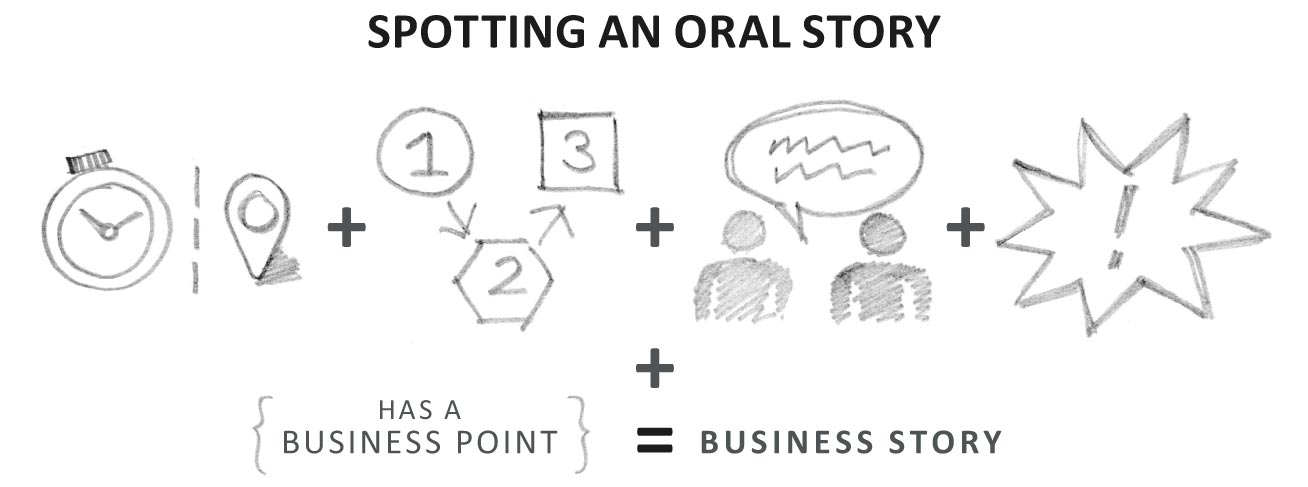Three vital business
storytelling tips
by Shawn Callahan
Want to cut through the noise at work and have your colleagues lean in when you speak? Sharing some well-chosen business stories can make all the difference. But to do it well you must apply these three business storytelling tips.
These vital tips are excerpts from the award-winning Putting Stories to Work: Mastering Business Storytelling by Shawn Callahan.
Be a good story spotter
Many people know what a story is until they are asked to find or tell one. To accurately spot stories, you need to train your ears to differentiate them from opinions, viewpoints, statements of fact, and the many other things that aren’t stories. This is an essential skill; without it, systematic and purposeful business storytelling is impossible. Our ability to spot stories is based on the simple fact that stories have structure, which is why Anecdote has developed a story spotting framework.

Before we go any further, let me just say that the story spotting framework is not an attempt to come up with a rigid definition of a story. Rather, it’s merely a tool that will help leaders to identify useful stories. In that context, the framework is a simple device that allows you to quickly decide whether something you’re hearing is a story or not. Now let me break it down for you.
Oral stories often begin with a time marker (denoted by the clock image). When you hear someone say, ‘Just this week…’ or ‘The other day…’ or ‘In 1991…’, it’s likely they are starting
a story. Of course, the fabled time marker is ‘Once upon a time…’, but let me tell you, avoid this phrase in business. It never goes down well.
Sometimes an oral story starts with a mention of place (place tag image); for example, ‘We were in the boardroom and Bill walked in…’ or ‘At the crusher Sam heard the bell…’
Stories mostly begin with either a time marker or a place marker because they are always set in a particular time and place.
Connected events are the bare essentials of a story (events image). Stories describe something that happened, and discrete events provide the backbone of this. When you hear someone using linking phrases such as ‘and then…’, ‘and after that…’, ‘but then…’ or ‘because of that…’, there’s a good chance you’re hearing a story.
The creators of the animated sitcom South Park, Trey Parker and Matt Stone, warn fledgling animators that if two scenes are separated with ‘and then…’, the result is likely to be a boring story. However, if the scenes are connected with the equivalent of ‘but…’ and ‘therefore…’, things stay interesting. We like to hear how people face and then resolve problems. That said, the view that a story must have a protagonist who faces and then overcomes a challenge, a notion highly influenced by Hollywood, is too narrow for business storytelling. For example, stories about coincidences lack a hero or a challenge, yet they are clearly stories that people love to tell. The story-rich podcast This American Life once dedicated an entire episode to coincidence stories.
Stories have people doing things, including talking (people image). If you hear someone’s name followed by what they did, or if you hear dialogue, the odds are you’re listening to a story. In fact, dialogue can only be delivered in a story—it’s a real giveaway.
A story is also a promise to share something the audience doesn’t know (wham image). To qualify as a story, there must be something in it that’s unanticipated. It doesn’t have to be a great insight, but the listeners should at least raise their eyebrows a little. That’s what makes it story-worthy.
Lastly, to be a business story, a story must have a business point.
Don’t mention the s-word
The word ‘story’ is vexed in business. Imagine this scene. A senior leader stands in front of his people to give a presentation on the company’s new direction. He says, ‘I would like to share a story with you’. If you were in that audience, what would you think or feel at that moment? When I pose this question to my workshop participants, they groan and wince. They say things like, ‘Here we go’, or ‘Don’t treat us like kids’, or ‘Just get to the point’, or ‘What trick
are they trying to pull?’
Now imagine that instead of, ‘I would like to share a story with you’, the senior leader says, ‘Something important happened a couple of weeks ago that I’d like to share with you.’ Hearing that, what would you think? Most people think, ‘Jeez, what happened?’ They are ready to listen.
In both cases the leader is about to tell a story, but in the first one the audience is put off by the s-word (story) which still has a negative connotation in many business settings. People don’t want to be told they are about to hear a story. Worse yet, they don’t want to be told they’re going to hear a funny story. They want to be the judge of that.
So I tell leaders taking part in Anecdote programs to avoid the s-word. I tell them to instead talk about an experience, something that happened, or to just jump right into the story with a time marker: ‘Three weeks ago, while I was at the Mildura plant…’ People love to hear stories. They just don’t like to be told they are listening to one.
Know your business point
Your default storytelling approach should be to begin an oral story with its point, or what I call a relevance statement. The easiest way to come up with one is to ask yourself, ‘What’s the main point my story is making?’ For example, if I wanted to tell a story about the importance of nurturing networks of people as a way of keeping a business agile, I’d start by saying something like, ‘One of the best ways to guard against the unpredictability of a crisis is to keep relationships strong and well connected across the company’. Then I’d launch into my 9/11 story that illustrates that point. With practice, this will become a natural conversation pattern for you: point, then story.
The relevance statement should pique the curiosity of your audience without giving too much away: if your story has a wonderful twist in its tail, for example, you don’t want to telegraph it. You just need to give listeners an idea of where you are going and why they might want to listen to you. In a sense, you are making a bold statement and the story will be the evidence for it.
Identifying the point of a story will also improve your storytelling no end. Your stories will become tighter because you’ll jettison anything that’s unnecessary in getting your message across. Above all, it ensures you actually have a point to make. Remember—a business story is only a business story if it has a point. The practice of sharing the relevance statement before you share the story ensures you have a good reason for telling the story. Telling stories with clear business points will only enhance your reputation at work. If you just go on and on without making a point, you risk becoming known as a gasbag.
After delivering your relevance statement, it’s important that you make a smooth transition to the story. Ideally, the story will remain invisible, by which I mean that after laying out your point of view, you shouldn’t suddenly announce, ‘Right, now I’m going to tell a story to back up my opinion’. Similarly, do not dramatically change your tone of voice or your gestures when you start telling the story. Simply continue to engage your audience in a conversation.
Once you’ve told your story, resist the urge to tell your listeners what the story means. A simple restating of the main point is OK, but if you say something like, ‘So what this story really means is…’, you prevent the audience from taking ownership of the story’s meaning. It’s like explaining a joke: it just kills its impact. And it doesn’t make a zip of difference to the listeners’ recall or comprehension. Let the audience members turn your story over in their minds and draw meaning from it themselves.
Want to improve your story skills? Check out our online training program, 7 Tips to be a Better Business Storyteller. Only $49.
Shawn Callahan is the author of Putting Stories to Work and the Founder at Anecdote, the world’s largest business storytelling company. You can get his book at www.puttingstoriestowork.com
He works with Global 1,000 companies such as Shell, Danone, Microsoft, TESCO, Allianz and Bayer all around the world.
Other articles by Shawn and the Anecdote team at www.anecdote.com/articles
Contact Shawn at:
Phone: +61 1300 720 537
www.anecdote.com
shawn.callahan@anecdote.com
twitter.com/shawncallahan
